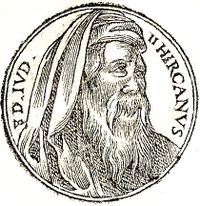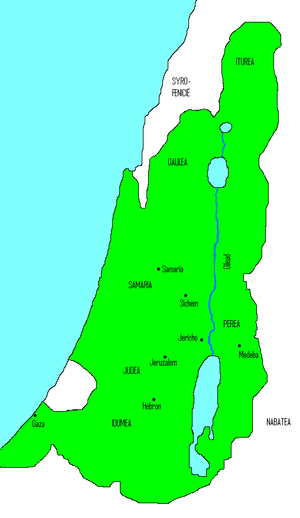هرقانس الثاني
هورقانوس الثاني ( /hərˈkeɪnəs/؛ بالعبرية: יוחנן הורקנוס Yohanan Hurqanos؛ إنگليزية: John Hyrcanus II)، عضو في الأسرة الهشمونية، كان لفترة طويلة الكاهن الأكبر اليهودي في القرن الأول ق.م.. وقد كان لفترة وجيزة ملك يهودا 67–66 ق.م. ثم الزعيم الملي ethnarch على منطقة يهودا، ربما للفترة 47–40 ق.م.[1]
| هـُرقانـُس الثاني Hyrcanus II | |
|---|---|
| ملك، زعيم ملي، والكاهن الأكبر على يهودا | |
 هورقانوس، بريشة Guillaume Rouillé's Promptuarii Iconum Insigniorum | |
| العهد | 76- 66 ق.م. و 63 - 40 ق.م. (كالكاهن الأكبر)؛ 67 - 66 ق.م. (كملك)؛ 47 - 40 ق.م. (كزعيم ملي) |
| سبقه | سالومى ألكسندرا |
| تبعه | أرسطوبلس الثاني، ثم Antigonus II بعد حكم هرقانس كزعيم ملي. |
| الأب | Alexander Jannaeus |
. . . . . . . . . . . . . . . . . . . . . . . . . . . . . . . . . . . . . . . . . . . . . . . . . . . . . . . . . . . . . . . . . . . . . . . . . . . . . . . . . . . . . . . . . . . . . . . . . . . . . . . . . . . . . . . . . . . . . . . . . . . . . . . . . . . . . . . . . . . . . . . . . . . . . . . . . . . . . . . . . . . . . . . .
ارتقاؤه العرش
Hyrcanus was the eldest son of Alexander Jannaeus, King and High Priest, and Alexandra Salome. After the death of Alexander in 76 BC, his widow succeeded to the rule of Judea and installed her elder son Hyrcanus as High Priest. Alexander had numerous conflicts with the Pharisees.[2] So Hyrcanus was believed to be supported by the Pharisees, especially later in his tenure.[3]
When Salome died in 67 BC, she named Hyrcanus as successor to the Kingship as well.[4]
الإطاحة به
Hyrcanus had scarcely reigned three months when his younger brother أرسطوبلس الثاني rose in rebellion. Hyrcanus advanced against him at the head of his mercenaries and his followers. The brothers met في معركة بالقرب من أريحا and many of Hyrcanus' soldiers went over to Aristobulus II, and thereby gave the latter the victory.[4]
Hyrcanus took refuge in the citadel of Jerusalem; but the capture of the Temple by Aristobulus II compelled Hyrcanus to surrender. A peace was then concluded, according to the terms of which Hyrcanus was to renounce the throne and the office of high priest, but was to enjoy the revenues of the latter office.[5]
التحالف مع النبطيين
This agreement however did not last, as Hyrcanus feared that Aristobulus was planning his death. Such fears were furthered by Hyrcanus' adviser Antipater the Idumean. According to Josephus, Antipater aimed at controlling Judea by putting the weak Hyrcanus back onto the throne.[4] Hyrcanus took refuge with Aretas III, King of the Nabataeans, who had been bribed by Antipater into espousing the cause of Hyrcanus by the promise of returning Arabian towns taken by the Hasmoneans.
The Nabataeans advanced toward Jerusalem with an army of 50,000, took the city and besieged the Temple where Aristobulus had taken refuge for several months. During the siege, the adherents of Hyrcanus stoned the pious Onias (Honi ha-Magel, also Khoni or Choni ha-Magel), who had refused to pray for the demise of their opponents, and further angered the priests who were fighting along with Aristobulus by selling them cattle for the paschal sacrifice for the enormous price of one thousand drachmae and then refused to deliver the promised animals for the sacrifice.(Antiquities of the Jews Book 14, 2:2)[6]
التدخل الروماني
During this civil war, the Roman general Pompey defeated the Kingdoms of Pontus and the Seleucids. He sent his deputy Marcus Aemilius Scaurus to take possession of Seleucid Syria.
As the Hasmoneans were allies of the Romans, both brothers appealed to Scaurus, each endeavoring by gifts and promises to win him over to his side. Scaurus, moved by a gift of 400 talents, decided in favor of Aristobulus and ordered Aretas to withdraw his army. During his retreat, the Nabateans suffered a crushing defeat at the hands of Aristobulus. Scaurus returned to Damascus.[7]
When Pompey arrived in Syria in 63 BC, both brothers and a third party that desired the removal of the entire dynasty (according to some sources, these may have been the representatives of the Pharisees), sent their delegates to Pompey, who however delayed the decision. He favoured Hyrcanus over Aristobulus, deeming the elder, weaker brother a more reliable ally of the Roman Empire.
Aristobulus, suspicious of Pompey, entrenched himself in the fortress of Alexandrium, but when the Romans summoned their army, he surrendered and undertook to deliver Jerusalem over to them. However, since many of his followers were unwilling to open the gates, the Romans besieged and captured the city by force, badly damaging city and temple. Aristobulus was taken to Rome a prisoner and Hyrcanus restored.[8]
الاستعادة
Around 63 BCE, Hyrcanus was restored to his position as High Priest but not to the Kingship. Political authority rested with the Romans whose interests were represented by Antipater, who primarily promoted the interests of his own house. In 47 BC, Julius Caesar restored some political authority to Hyrcanus by appointing him ethnarch. This however had little practical effect, since Hyrcanus yielded to Antipater in everything.[7]
المنفى
In 40 BC, Aristobulus' son Antigonus Mattathias allied himself with the Parthians and was proclaimed King and High Priest.[7] Hyrcanus was seized and mutilated at his ears (according to Josephus, Antigonus bit his uncle's ears off) to make him permanently ineligible for the priesthood.
Then Hyrcanus was taken to captivity in Babylonia by the Parthians,[9] where for four years he lived amid the Babylonian Jews, who paid him every mark of respect.
العودة إلى القدس والوفاة
In 36 BC, Herod I, who had vanquished Antigonus with Roman help and feared that Hyrcanus might induce the Parthians to help him regain the throne, invited the former High Priest to return to Jerusalem. Hyrcanus accepted and Herod received him with every mark of respect, assigning to him the first place at his table and the presidency of the state council.
However, in 30 BC Herod charged Hyrcanus with plotting with the Nabateans and put him to death. When he died, Josephus says that he was 80 years old.
Biblical scholar Gregory Doudna proposed in 2013 that Hyrcanus II was the figure known as the Teacher of Righteousness in the Qumran Scrolls.[10][11] According to Doudna, Hyrcanus II’s sectarian orientation is now generally understood to have been Sadducee.
انظر أيضاً
الهامش
- ^ The Armies of the Hasmonaeans and Herod– Google Knihy. Books.google.cz. January 1, 1991. Retrieved 2016-10-20.
- ^ Alexander Jannaeus jewishencyclopedia.com
- ^ Hyrcanus II jewishencyclopedia.com
- ^ أ ب ت "Hyrcanus II", Jewish Encyclopedia"
- ^ Schürer, "Gesch." i. 291, note 2
- ^ Josephus Flavius. "The Antiquities of the Jews". Retrieved 5 April 2015.
- ^ أ ب ت Hoehner, H.W., "Hasmoneans", International Standard Bible Encyclopedia: E-J, Geoffrey W. Bromiley (ed.), Wm. B. Eerdmans Publishing, (1995)
- ^ Rocca, Samuel. The Forts of Judaea 168 BC-AD 73: From the Maccabees to the Fall of Masada, Osprey Publishing, (2008)
- ^ Hammond & Goodman 2017.
- ^ David Stacey, Gregory Doudna, Qumran Revisited: A Reassessment of the Archaeology of the Site and its Texts. BAR international series, 2520. Oxford: Archaeopress, 2013. ISBN 9781407311388
- ^ Gregory Doudna, A Narrative Argument that the Teacher of Righteousness was Hyrcanus II. Excerpted from pp. 95-107 of the book
- This article incorporates text from the 1901–1906 Jewish Encyclopedia article "Hyrcanus II", a publication now in the public domain.
ببليوجرافيا
المصادر
- Hammond, Martin; Goodman, Martin, eds. (2017). The Jewish War, by Josephus. Oxford: Oxford University Press. ISBN 978-0191057595.
{{cite book}}: Invalid|ref=harv(help) - Flavius Josephus, Antiquities of the Jews, book XIV, 5-13.
- Flavius Josephus, The Jewish War, book I, 8-13.
أدبيات
- Heinrich Ewald, Geschichte des Volkes Israel, volume IV, p. 524ff.
- Heinrich Graetz, History of the Jews, volume III, p. 167ff.
- Hitzig[مطلوب توضيح], Geschichte des Volkes Israel, volume II, p. 500ff.
- Emil Schürer, Geschichte des judischen Volks im Zeitalter Jesu Christi, volume I, p. 338 et seq.
هرقانس الثاني توفي: 30 BC
| ||
| ألقاب يهودية | ||
|---|---|---|
| سبقه Alexander Jannaeus |
High Priest of Judea 76 BC – 66 BC |
تبعه Aristobulus II |
| سبقه Salome Alexandra |
King of Judea 67 BC – 66 BC | |
| سبقه Aristobulus II |
High Priest of Judea 63 BC – 40 BC |
تبعه Antigonus II |
| Ethnarch of Judea 47 BC – 40 BC | ||
